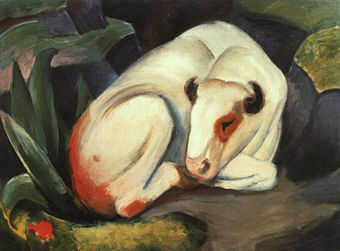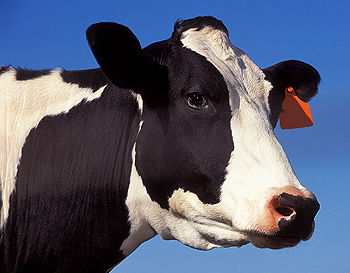Cattle
Cattle most commonly refers to the species Bos taurus,[1] as raised for agriculture. Properly, a cow is the female of the species, although "cows" and "cattle" often are used interchangeably. Bull refers to a male that has not been castrated while a steer or bullock is a castrated male. Bull and cow are also used to refer to males and females of species as diverse as elephants and whales. Bovine is the adjective although also used as a noun.
Beef is the meat of adult cattle while veal comes from immature animals. Cows also produce milk, the base of the dairy industry.
Religious symbolism
Cattle have symbolic roles in many religions, with the symbolism ranging from adequate food to cows representing fertility.
The constellation Taurus represents a bull.
Industry

The United States has the largest fed-cattle industry in the world, and is the world's largest producer of beef, primarily high-quality, grain-fed beef for domestic and export use. The industry is roughly divided into two production sectors: cow-calf operations and cattle feeding.[2] The economic significance of this industry justifies oversight both by the U.S. Department of Agriculture in the executive branch. In the Congress, the Livestock, Dairy, and Poultry Subcommittee of the House Committee on Agriculture and the Subcommittee on Domestic & Foreign Marketing, Inspection, & Plant & Animal Health of the Senate Committee on Agriculture, Nutrition and Forestry can be said to have policy responsibility, in the U.S. government, for bull and related matters.
References
- ↑ Bos taurus, National Center for Biotechnology Information
- ↑ Cattle: Background, Economic Research Service, U.S. Department of Agriculture
